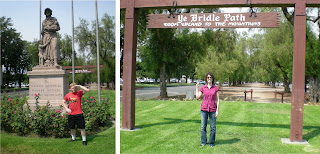For many, the mythology of Route 66 is larger than life, but those that have actually traversed the Mother Road know that some of it really is. Large, I mean. Nowadays, we like our excesses as small as possible, like our cell phones or smart cars, but when Route 66 was an active American highway, we commemorated its grand scope and vision with things just as grand in size. Even in the relatively short stretch between San Bernadino, California and Holbrook, Arizona, my girlfriend and I beheld plenty of pompous pavement props, now chronicled here! I've decided to categorize them as either "the wonders of the world" or "the marvels of man," as these enormous attractions must've been built with the intention of celebrating something significant . . . right?
The Wonders of the World
One of the first "giant alerts" my girlfriend and I encountered was Bono's Historic Orange Stand, which, contrary to popular belief, does not belong to U2's lead singer but instead the late Bono family, who owned and operated an Italian restaurant next door. Other "giant orange" stands were opened by Frank E. Pohl in the '20s and '30s and celebrated the region's rich bounty, but this is one of the few that remain standing, complete with Route 66, ahem, appeal. Yeah, sorry about that.
The next few images depict the virtual zoo of enormous animals that inhabit the Route 66 roadside, from the Polly Gas parrot outside of Barstow, to the sadly squashed roadrunner of the Roadrunner's Retreat and Restaurant near Amboy.
Of course, my favorite of these quiche creatures is the jackrabbit outside of the aptly named Jack Rabbit Trading Post in Joseph City, Arizona. Billboards boast the bodacious bunny for miles, inviting spectators to ride the rabbit, so I couldn't resist. Surely if you've been looking to fulfill your giant jackrabbit needs, the sign outside of the trading post tells you where such satisfaction awaits: "Here it is!"
What better way to bookend Route 66's world wonders than with another plant, though unlike Bono's faux fruit, this one is real -- oh, at least it was. The world's largest petrified tree is also in Joseph City, though I don't think you can ride it.
The Marvels of Man
This batch of towering tourist traps truly celebrates humanity's rich history along Route 66, starting with the Madonna of the Trail and Ye Bridle Path in Upland. The former honors the colonial women damned to hear the cries of their children while exploring the Old West, the latter the upward climb to the region's neighboring mountains.

In the context of Old West exploration, this magic lamp might seem out of place, but hear me out on this one. What better way to epitomize how those old explorers' wishes of Manifest Destiny were coming true than building a restaurant/bar with a genie's home out front? You're welcome, Magic Lamp Inn.

The rest of the attractions we encountered were definitively Old West, celebrating the stereotypical culture of cowboys and Indians. For instance, behold this totem pole outside of the Grand Canyon Caverns in Peach Springs, Arizona -- and more importantly consider the bold political statement my gorgeous girlfriend is making. Indeed, to the untrained, even cynical eye, one might assume she is desecrating the spirit of the totem by simulating a pole dance, but the socially analytical mind would realize she is merely physically commenting on how contemporary accounts of history have unnecessarily sexualized Native American culture through such sultry depictions like Dances With Wolves or even Disney's Pocahontas. Yes. She is just that brilliant.



Two of my favorite stops on our trip were Two Guns and Twin Arrows in Arizona. The Two Guns site is little more than the remnants of an old theme park (and debris-ridden, so beware, drivers!), and the Twin Arrows, thankfully recently renovated, mark the spot of an old trading post/cafe, but considering their close proximity to one another, my inner child can't help but think that the two represent the timeless conflicts of the Old West. Perhaps, back in the day, giant cowboys and giant Indians fought in this desert stretch, with these the only signs of that lofty legendary battle. Maybe that's why they call it "high" noon -- because these old icons were just that tall . . . or you'd have to be high to think of such a thing.

Finally, the best way to end this journal of our gigantic journey is here, at the Wigwam Motel in Holbrook, Arizona. These wigwams are truly larger than life, and for a price as reasonable as any other roadside motel, you can sleep in one! In a way, residing in a wigwam if only for one night helps the weary traveller feel as big as the other giants along Route 66, becoming in some small way a part of the grand mythology that consumes America's Mother Road. I was certainly grateful for our stay in that strange round room, which reminded me that no matter how far we've come from Route 66's rich history, no matter how our tastes have seemingly shrunk over the years, some things eventually come full circle. High hopes for humanity, indeed . . .










No comments:
Post a Comment